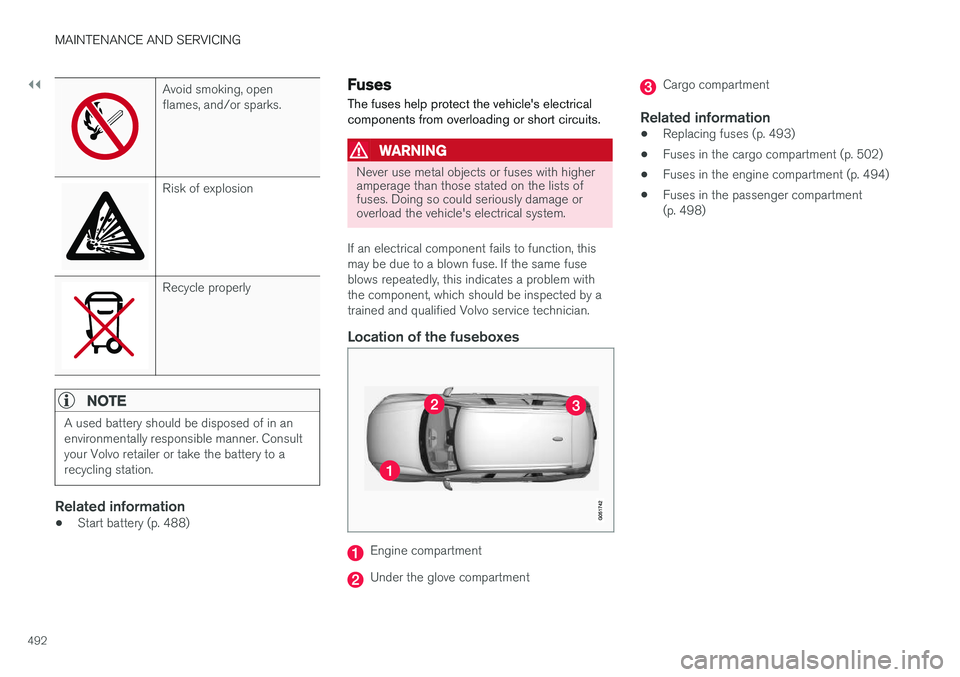Page 494 of 560

||
MAINTENANCE AND SERVICING
492
Avoid smoking, open flames, and/or sparks.
Risk of explosion
Recycle properly
NOTE
A used battery should be disposed of in an environmentally responsible manner. Consultyour Volvo retailer or take the battery to arecycling station.
Related information
•Start battery (p. 488)
Fuses The fuses help protect the vehicle's electrical components from overloading or short circuits.
WARNING
Never use metal objects or fuses with higher amperage than those stated on the lists offuses. Doing so could seriously damage oroverload the vehicle's electrical system.
If an electrical component fails to function, this may be due to a blown fuse. If the same fuseblows repeatedly, this indicates a problem withthe component, which should be inspected by atrained and qualified Volvo service technician.
Location of the fuseboxes
Engine compartment
Under the glove compartment
Cargo compartment
Related information
• Replacing fuses (p. 493)
• Fuses in the cargo compartment (p. 502)
• Fuses in the engine compartment (p. 494)
• Fuses in the passenger compartment (p. 498)
Page 495 of 560
MAINTENANCE AND SERVICING
493
Replacing fuses The fuses help protect the vehicle's electrical components from overloading or short circuits.
Fuse replacement1. See the list of fuse boxes for their locations.
2. Pull the fuse straight out and examine it fromthe side to see if the curved metal wire in the fuse is intact.
3. If the wire is broken, insert a new fuse of the same color and amperage (written on thefuse).
WARNING
Never use metal objects or fuses with higher amperage than those stated on the followingpages. Doing so could seriously damage oroverload the vehicle's electrical system.
Related information
• Fuses (p. 492)
• Fuses in the cargo compartment (p. 502)
• Fuses in the engine compartment (p. 494)
• Fuses in the passenger compartment (p. 498)
Page 497 of 560
MAINTENANCE AND SERVICING
}}
495
There is a fuse removal tool on the inside of the fuse box cover. There are also positions in thefuse box for several extra fuses.PositionsThere is a decal on the inside of the cover with alist of fuses.
Page 500 of 560
MAINTENANCE AND SERVICING
498
Fuses in the passenger compartment
The fuses in the passenger compartment (located under the glove compartment) help pro- tect electrical components such as the 120-voltsocket, displays and door modules.
There is a fuse removal tool on the inside of thefuse box covers. There are also positions in thefuse box for several extra fuses.
Page 505 of 560
MAINTENANCE AND SERVICING
}}
503
The fuse box is under the storage compartment on the right side
There is a fuse removal tool on the inside of the fuse box cover. There are also positions in thefuse box for several extra fuses.
Page 517 of 560

MAINTENANCE AND SERVICING
}}
515
Hood completely closed
Related information
•Engine compartment overview (p. 515)
• Door and seat belt reminders (p. 64)
Engine compartment overview
The engine compartment overview shows some maintenance points.
The layout of the engine compartment may differ slightly from model to model
Coolant expansion tank
Brake fluid reservoir
Washer fluid reservoir
Relay/fuse box
Air cleaner
Engine oil filler cap
WARNING
• The cooling fan (located at the front of the engine compartment, behind the radi-ator) may start or continue to operate (forup to 6 minutes) after the engine hasbeen switched off.
• Engine cleaning should only be done by aworkshop. If engine cleaning agents areused when the engine has been running,there may a fire risk.
• Before performing any operations in theengine compartment, the ignition shouldalways be completely switched off (in mode
0) and there should be no remote
keys in the passenger compartment. Thegear selector should be in the P (park)
position. If the engine has been running, wait until it has cooled before touchingany components in the engine compart-ment.
• The distributor ignition system operatesat very high voltages. Special safety pre-cautions must be followed to preventinjury. Always turn the ignition off whenreplacing distributor ignition componentse.g. plugs, coil, etc.
• Do not touch any part of the distributorignition system while the engine is run-ning. This may result in unintended move-ments and body injury.